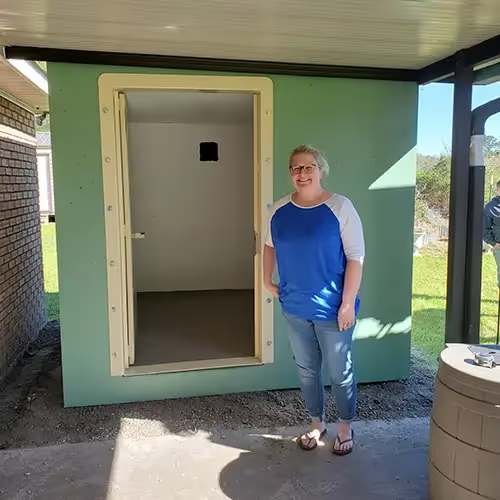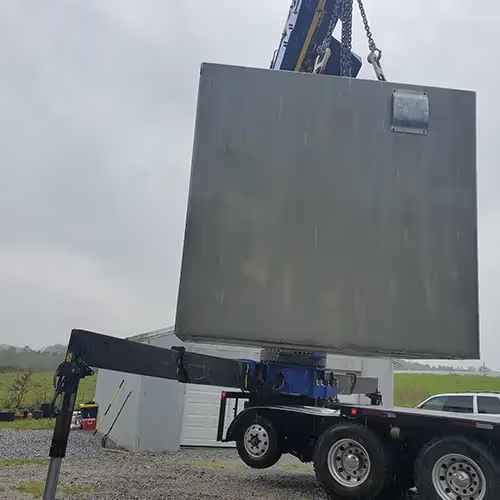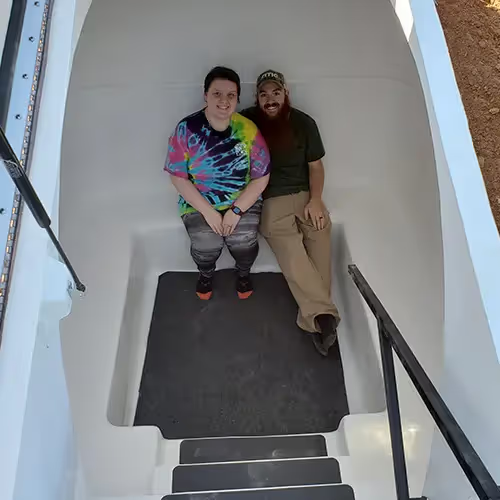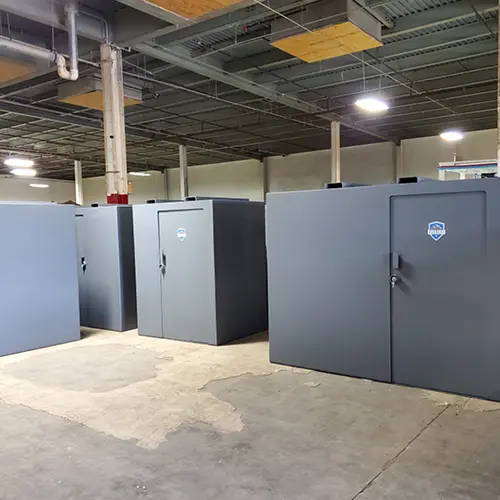Storm Shelter Cost Factors in Alabama: Materials, Size, and Site Conditions


Have you ever wondered why Alabama storm shelter price can vary dramatically from one home to another? Some homeowners may find a bargain, while others spend nearly double for similar-sized shelters. The cost is not one-size-fits-all because several factors determine the final price. Key elements include storm bunker materials, underground shelter size guide, and site conditions, all of which directly affect your budget. These factors influence not only the upfront installation costs but also long-term expenses such as storm shelter maintenance cost and potential storm shelter upgrade cost.
Understanding these cost drivers upfront can save homeowners time, effort, and money. For instance, concrete storm shelter cost may be higher due to labor-intensive installation, while prefabricated storm shelter price often comes with the convenience of quick setup. Similarly, steel storm shelter cost varies depending on durability, pre-fabrication, and size customization. Other considerations like storm cellar foundation requirements and storm shelter excavation cost can significantly influence total costs, particularly in areas with difficult soil or high water tables.
Families looking for safety and peace of mind should also consider features like storm shelter ventilation cost, storm shelter door price, and storm shelter interior options, which enhance comfort during severe weather events. By the end of this guide, you’ll understand these cost factors, discover practical storm shelter construction tips, and gain insight into planning for your family’s safety without overspending. Recognizing how these elements affect price allows you to make informed decisions and ensure your shelter meets both budget and safety requirements.
Understanding Storm Shelters in Alabama: A Brief Background
Storm shelters have a long history in Alabama and the broader South, where families sought protection from severe weather long before standardized shelters existed. Early shelters were simple dugouts or underground cellars built from whatever materials were available. Over time, tornado activity and increased storm awareness prompted the evolution of more durable, regulated shelters, with adherence to storm shelter building codes Alabama. Today, these shelters come in various forms: above-ground, underground, or specialized safe rooms. Each type serves a unique purpose but shares the common goal of providing a secure, reinforced space capable of withstanding tornado-force winds and flying debris.
Modern shelters often feature basement storm shelter installation, modular storm shelter price, and custom storm shelter dimensions to fit specific household needs. Families now have a wide range of options, from prefabricated storm shelter price models that are convenient to install, to fully custom designs tailored for long-term durability and comfort. Interest in shelters has grown due to unpredictable weather patterns and frequent tornado warnings, prompting homeowners to prioritize safety as a key factor in property planning.
Additionally, awareness of storm shelter ventilation cost and other comfort-related elements has increased. Innovations in materials, structural design, and installation processes have made shelters safer and more efficient. For homeowners who want guidance on stocking their shelters, the storm cellar essential supplies article is a helpful resource. By recognizing the differences among shelter types and their associated costs, families can make informed choices that maximize safety and value while aligning with personal and property needs.
The Role of Materials in Storm Shelter Costs
Material selection is one of the most critical factors influencing tornado safe room cost. Different materials provide varying levels of durability, safety, and long-term value, directly affecting Alabama storm shelter price. Common options include concrete, steel, fiberglass, and hybrid combinations, each with its advantages and trade-offs. Concrete shelters, for example, are extremely strong and resistant to wind and debris but can significantly increase concrete storm shelter cost due to labor-intensive installation and required professional expertise. Steel shelters are durable and often come as pre-fabricated units, which may raise steel storm shelter cost or prefabricated storm shelter price depending on customization. Fiberglass and composite shelters are lighter, easier to transport, and often more affordable upfront, though they may require more frequent maintenance over time.
Hybrid options combine the strengths of multiple materials, such as steel framing with concrete panels, offering a balance of durability, price, and installation flexibility. When evaluating options, homeowners should consider storm shelter material durability, long-term storm shelter upgrade cost, and ongoing storm shelter maintenance cost. Other cost factors include foundation needs (storm cellar foundation requirements) and site preparation, which may impact storm shelter excavation cost.
Choosing the right material also influences comfort, safety, and emergency preparedness. Homeowners should evaluate storm shelter interior options, ventilation (storm shelter ventilation cost), door types (storm shelter door price), and overall structural design. For a full checklist on materials, compliance, and safety, see Alabama storm shelter checklist. By understanding the relationship between materials and costs, families can prioritize their shelter’s primary goals—safety, durability, and budget—while ensuring long-term peace of mind.
Why Shelter Size Matters for Cost and Safety
Choosing the correct shelter size is essential for safety, comfort, and cost management. A well-sized shelter, guided by an underground shelter size guide, allows families to prepare effectively for emergencies without overspending. Size affects not only Alabama storm shelter price but also usability during high-stress situations. Proper sizing ensures all household members—and pets—have enough space while maximizing comfort and minimizing panic during storms. Families can plan for immediate needs while leaving room for future growth or temporary guests.
The right size can also influence storm shelter space planning, construction costs, and long-term usability. A small shelter may seem cheaper upfront but may fail to accommodate all occupants safely, while an oversized shelter increases storm shelter installation cost without added benefits. For example, a family of four may invest in a mid-sized underground shelter designed for six occupants. Though the initial cost rises, the additional capacity allows extended family to safely occupy the space during tornado season, providing peace of mind and long-term value.
Key benefits of proper sizing include:
- Cost Control – Avoid spending on unneeded materials or labor
- Family Comfort – Enough room for everyone reduces anxiety
- Space Efficiency – Integrates with yard or garage layout
- Future-Proofing – Accommodates potential household growth
Ultimately, selecting the right size balances cost, safety, and usability, ensuring the shelter serves its purpose during emergencies without unnecessary expense.
Site Conditions and Installation Challenges
Your property’s unique site conditions can significantly influence storm shelter construction costs and installation complexity. Soil type, drainage, yard space, and existing utilities all factor into overall Alabama storm shelter price. For example, rocky or sandy soils may require additional reinforcement or excavation, affecting storm shelter excavation cost. High water tables may necessitate drainage solutions or elevated shelters, impacting flood-resistant storm shelter cost. Limited space can affect storm shelter design considerations, while existing utilities may require special planning to avoid conflicts. Compliance with storm shelter permits Alabama is also critical to avoid delays or fines.
Homeowners can mitigate challenges by:
- Conducting a professional site assessment
- Choosing a shelter type suited to property conditions, such as above-ground or modular designs
- Partnering with installers familiar with storm shelter local suppliers and local regulations
- Planning extra time for permit approval and inspections
Each property is unique, but nearly all obstacles are manageable with proper planning. Effective storm shelter installation guide strategies ensure that soil, water, space, and utility considerations are addressed before construction begins. Families gain confidence knowing their shelter fits both their land and lifestyle while complying with safety and regulatory requirements. Thoughtful site preparation minimizes cost surprises, reduces installation challenges, and ensures long-term usability, making your investment both safe and practical.
Planning and Budgeting Your Storm Shelter
Proper planning is crucial to control tornado safe room cost and ensure a reliable, safe shelter. Step-by-step planning helps homeowners balance safety, comfort, and storm shelter financing options.
Key steps include:
- Assess Your Needs – Determine occupancy, location, and accessibility (emergency storm shelter options)
- Set Your Budget – Factor in storm shelter maintenance cost, storm shelter upgrade cost, and storm shelter warranty options
- Site Evaluation – Check soil, water table, and utility placement
- Research Permits – Review storm shelter permits Alabama requirements
- Compare Contractors – Evaluate storm shelter contractor rates and experience
- Plan Installation Logistics – Prepare site and access for equipment (storm shelter installation guide)
- Finalize and Schedule – Lock in dates to avoid delays during storm season
Tools like storm shelter comparison chart, cost calculators, and local directories simplify research and planning. Careful budgeting allows homeowners to weigh storm shelter door price, materials, and storm shelter interior options while remaining within financial limits. By following structured planning steps, families can make informed decisions and achieve the optimal balance between cost, safety, and long-term utility.
The Future of Storm Shelters in Alabama
Storm shelters are evolving rapidly, driven by material innovation, regulatory changes, and homeowner demand. Advanced composites improve storm shelter energy efficiency and durability, while modular designs may reduce storm shelter installation cost. Features like enhanced ventilation (storm shelter ventilation cost) and emergency communication systems are becoming standard.
Communities may see increased adoption of shared or municipal shelters, providing cost-effective solutions. Incentives and funding programs can further offset storm shelter financing options for families. Customization, including ADA-accessible units (storm shelter accessibility features), ensures comfort, accessibility, and compliance with safety standards. These trends provide homeowners with more affordable, flexible, and efficient options to meet evolving safety needs.
Wrapping It Up
Storm shelters are a critical investment for Alabama homeowners. Considering storm shelter door price, storm shelter interior options, and storm shelter roof type comparison ensures comfort and compliance. Long-term value includes storm shelter resale value and peace of mind during emergencies. Homeowners can also explore DIY storm shelter cost options if appropriate, while relying on professional guidance to meet safety and regulatory standards.
Planning carefully, selecting durable materials, and understanding cost drivers like concrete storm shelter cost, steel storm shelter cost, and storm bunker materials allow families to balance safety and affordability. Start today by consulting local providers, evaluating your property’s conditions, and selecting a solution that provides long-term protection for your family.



